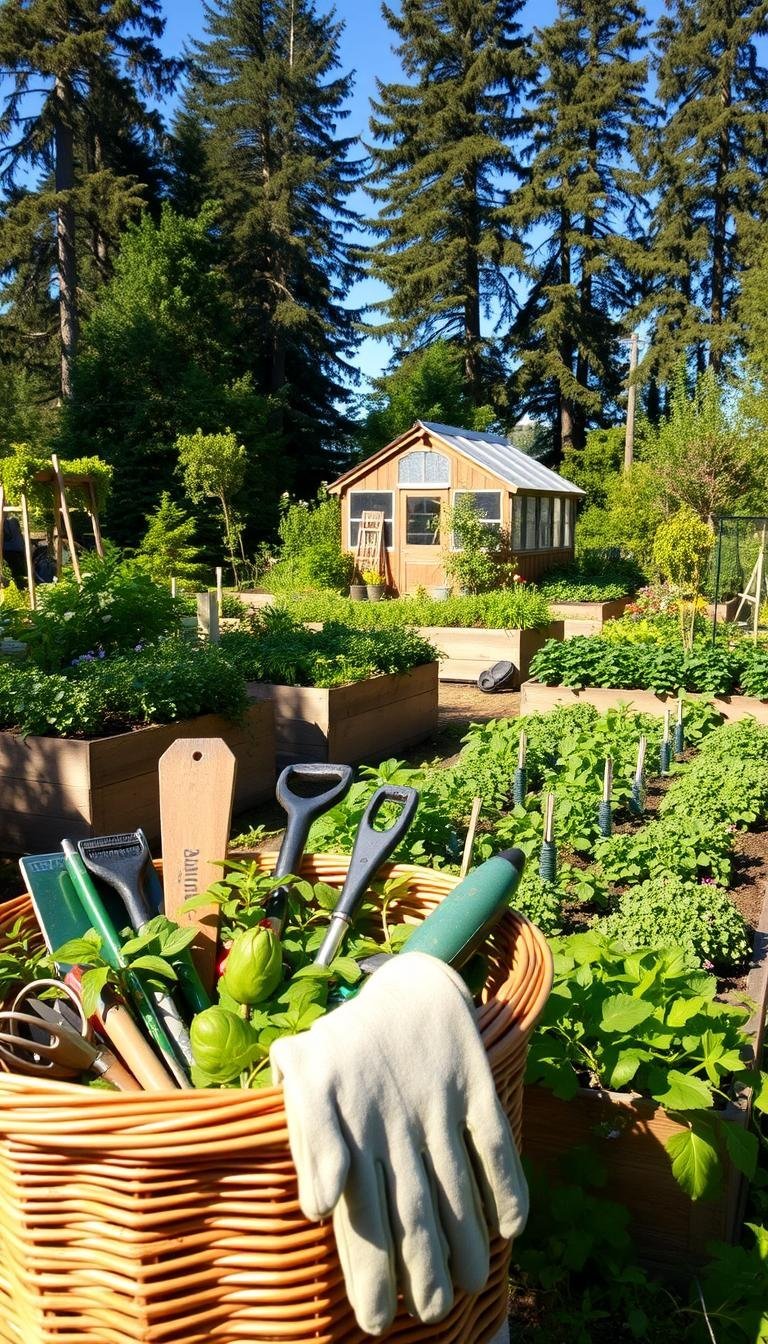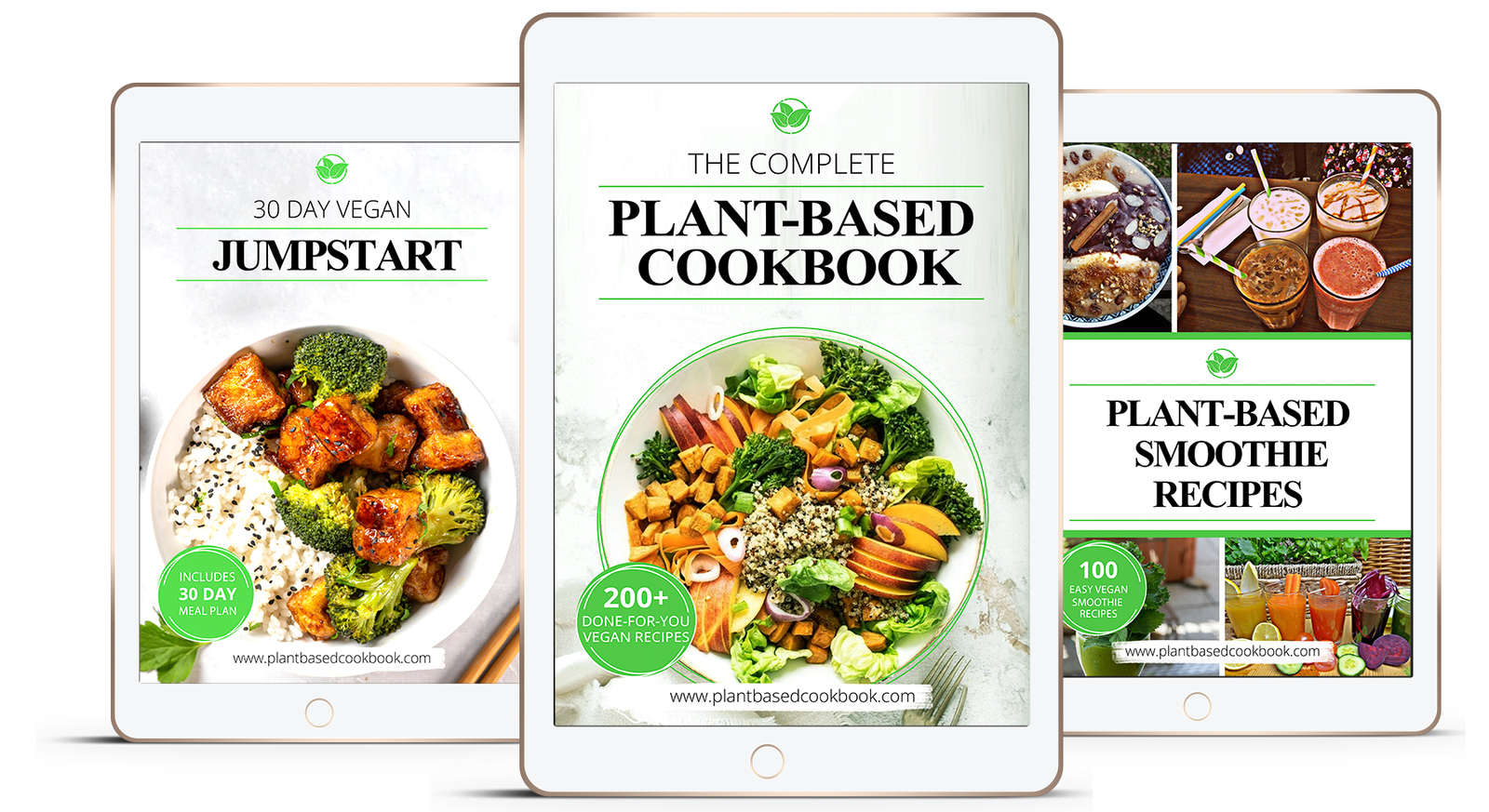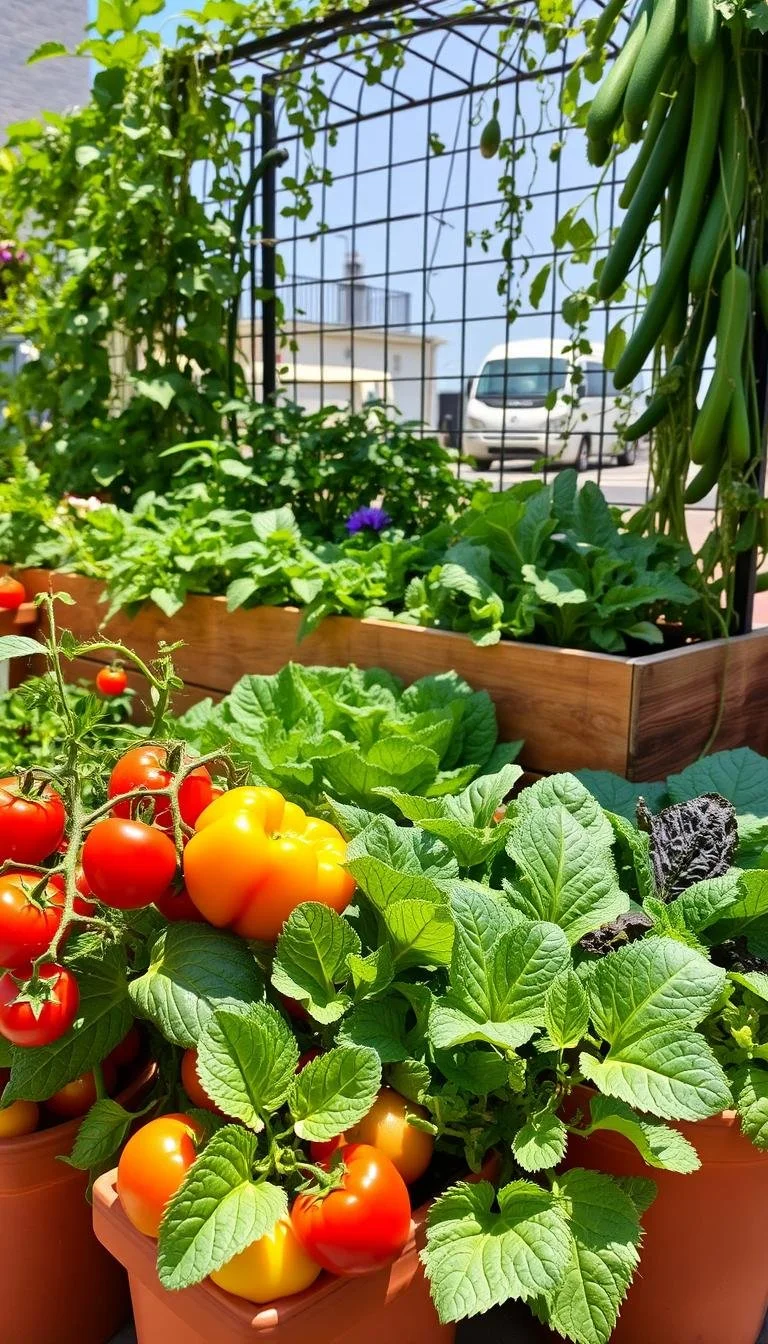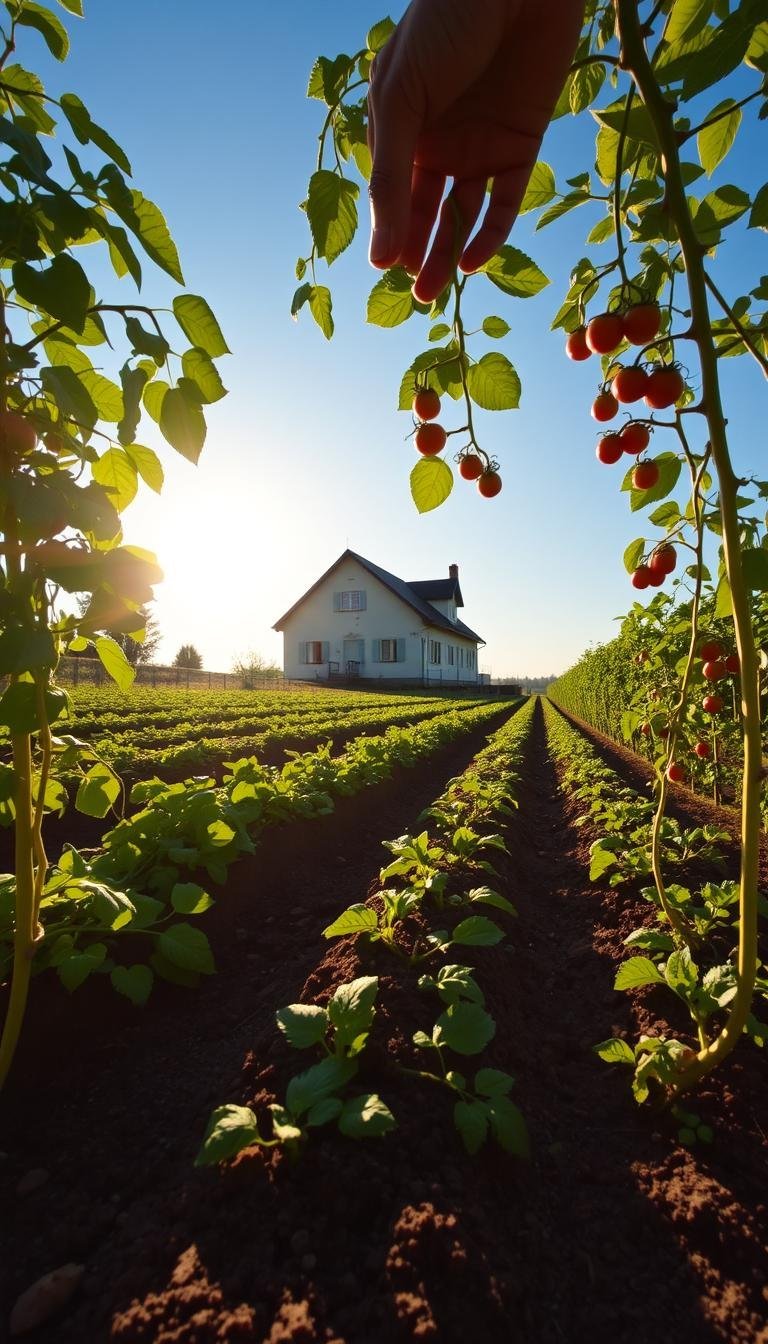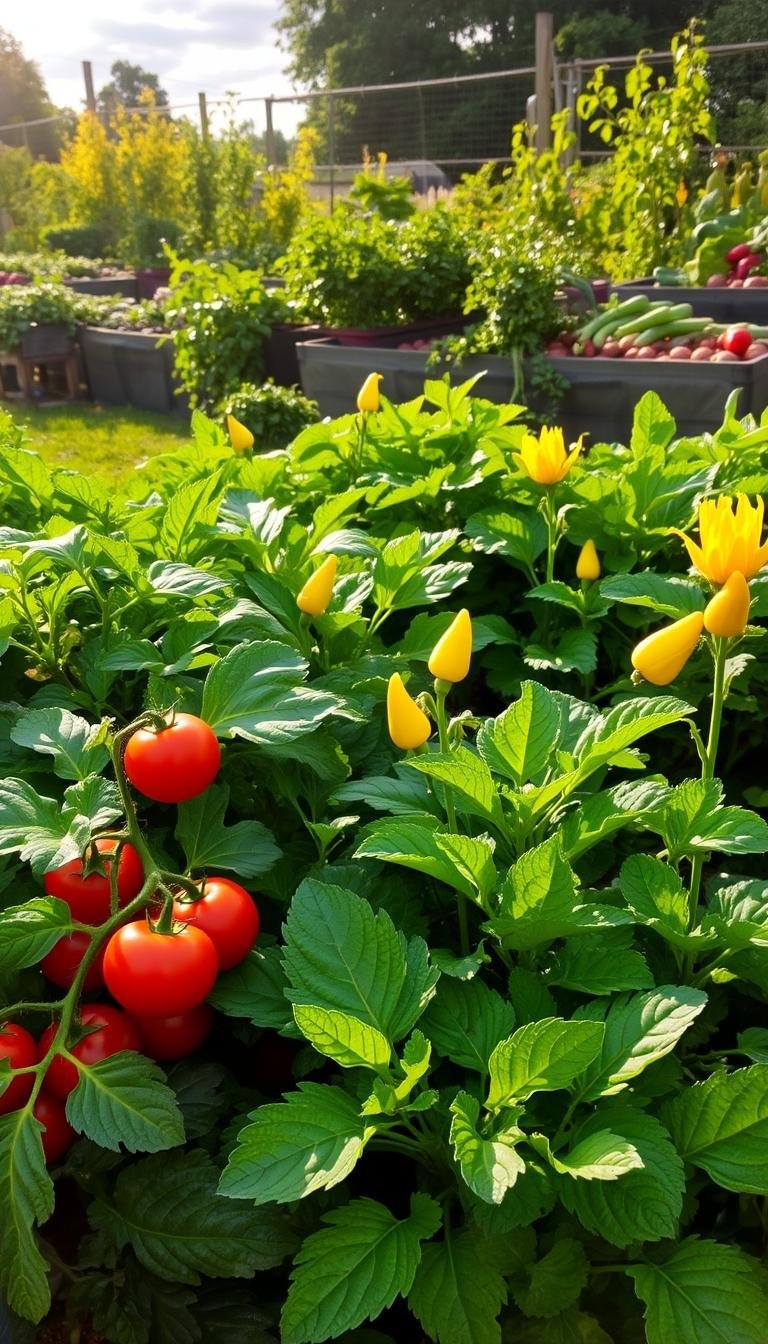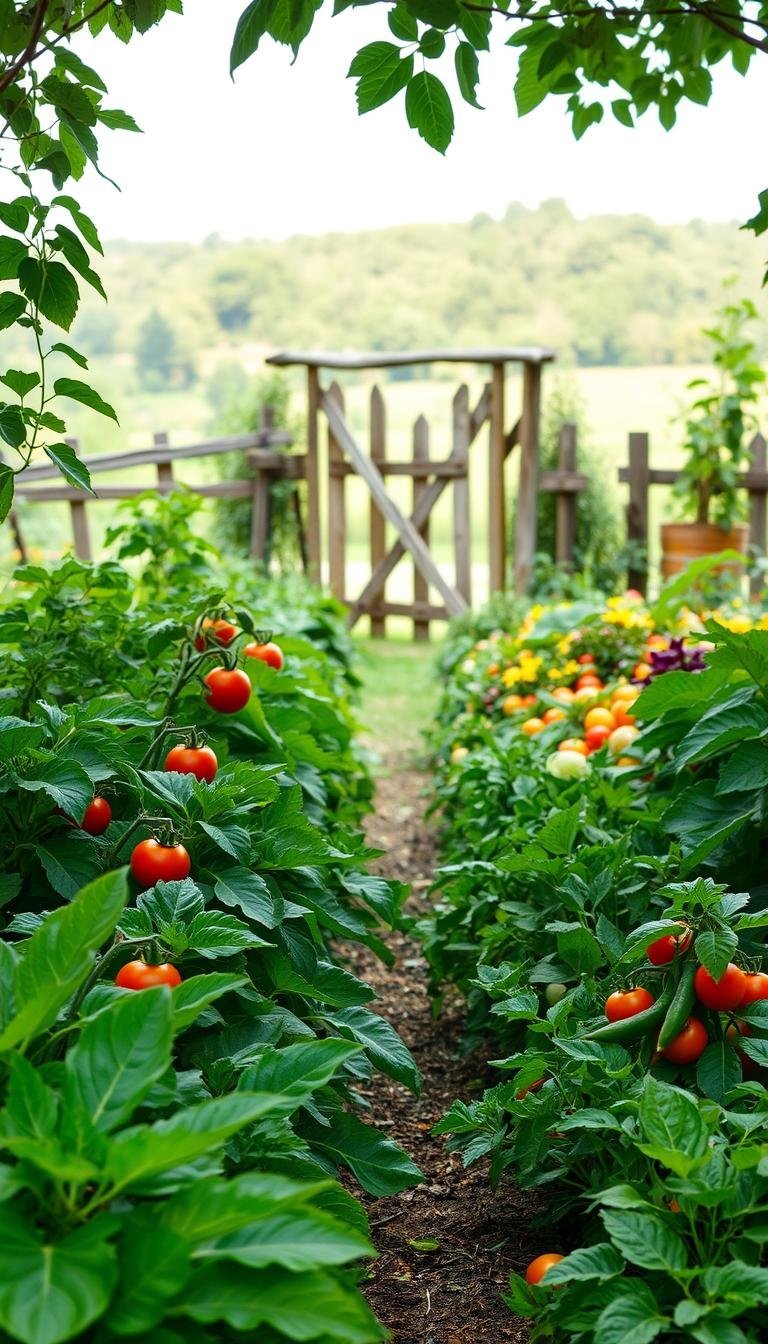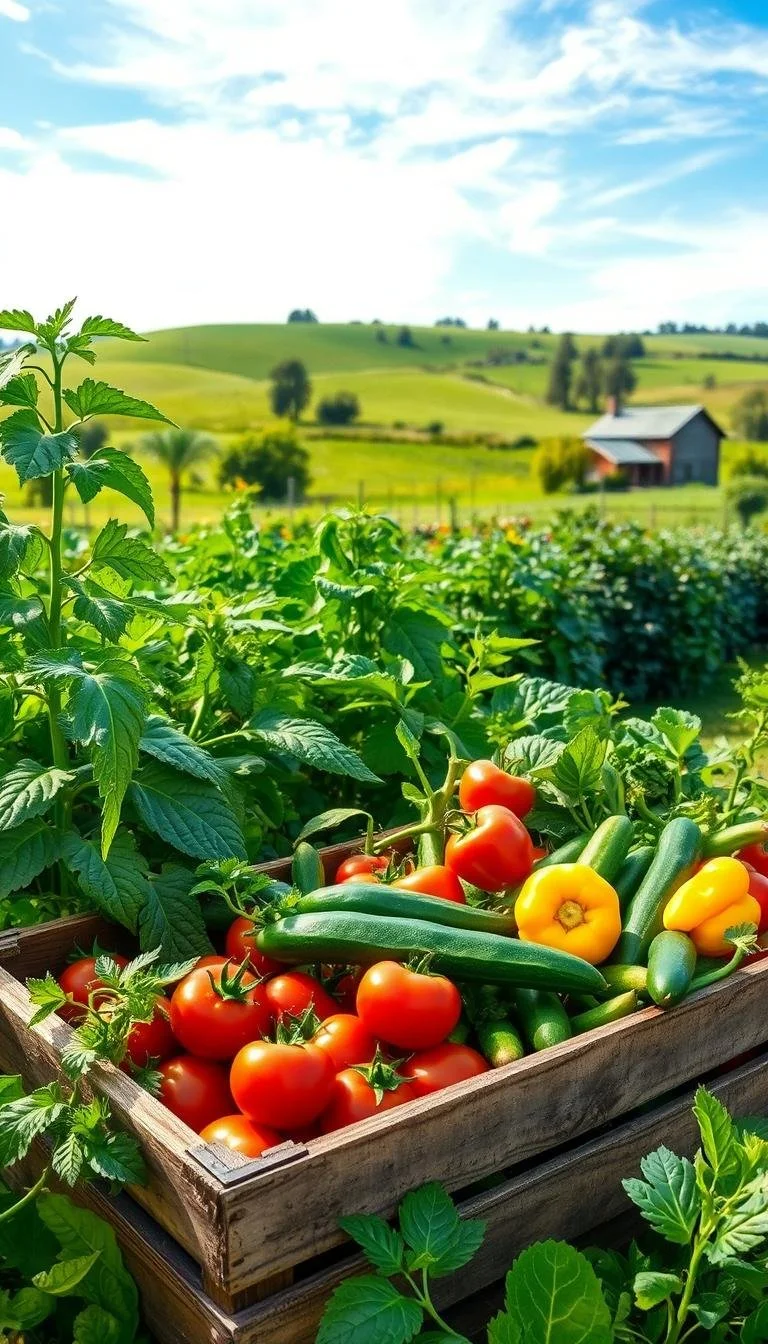(Hey! Some links in this post may be affiliate links — meaning I may earn a small commission if you buy through them, at no extra cost to you. As an Amazon Associate, I earn from qualifying purchases. I only share products I genuinely love and think you’ll find useful too. Read the full disclosure here).
Gardening is a rewarding hobby for everyone, no matter your experience. You can grow vegetables, flowers, or herbs. This guide will help you start small and build confidence.
Millions of people find gardening fun and easy. With basic tools and a little space, you can create a thriving garden.
🌿 Want to Take Your Garden to the Next Level?
If you're serious about growing your own food and becoming more self-reliant, The Self-Sufficient Backyard is a must-read...
🌱 Learn MoreThis guide covers everything you need to get started. You’ll learn how to choose the best spot for your plants and the right tools. Starting a garden is simple.
You’ll learn to pick plants that grow well in your area and care for them. Even small spaces like balconies or patios can be great for your first garden.
In this guide, you’ll find simple strategies for success. We’ll show you how to avoid common mistakes and enjoy watching your garden grow. Let’s make your gardening dreams come true, one step at a time.
Contents
- 1 Why Gardening is Great for Beginners
- 2 Choosing the Right Location for Your Garden
- 3 Essential Tools for Starting Your Garden
- 4 Selecting the Best Plants for Beginners
- 5 Soil Preparation for Gardening Success
- 6 Understanding Planting Seasons and Timing
- 7 Watering Techniques for Healthy Plants
- 8 Simple Pest Control Strategies
- 9 Fertilizing Your Garden for Optimal Growth
- 10 Learning About Companion Planting
- 11 Harvesting Your Garden’s Produce
- 12 Continuing Your Gardening Journey
Why Gardening is Great for Beginners
Gardening brings health and happiness. For new gardeners, simple gardening for beginners offers many benefits. It’s not just about growing food. It’s about improving your life and saving money too.
Benefits of Gardening for Mind and Body
Research shows gardening lowers stress and lifts your mood. Activities like digging and watering are calming. A 2019 study in Journal of Therapeutic Horticulture found gardeners feel less anxious. Gardening also adds exercise, strengthening your body without a gym.
- Mental clarity: Weeding improves focus.
- Physical activity: Gardening burns 200–400 calories per hour.
- Nature connection: Sunlight boosts vitamin D and energy.
Budget-Friendly Gardening Tips
Starting a garden for beginners doesn’t need to cost a lot. Here are some easy garden ideas:
- Use yogurt containers or egg cartons as seed starters.
- Buy seed packets instead of pricier seedlings.
- Shop for tools at thrift stores or borrow from neighbors.
Even small spaces can be used. Window boxes, balcony pots, or community plots are great for growing herbs or greens. You don’t need a big yard.
Choosing the Right Location for Your Garden
Finding the perfect spot is the first step in how to start a garden. Even small areas like patios or balcony containers can do well with the right planning. Start by looking at your yard or outdoor space for sunlight and soil conditions.
Evaluating Sunlight Exposure
Most plants need at least 6 hours of sunlight each day. Use a notebook to track the sun’s patterns over a day. Getting started with gardening means knowing where shadows fall at different times. For shady spots, choose plants like lettuce or ferns. Full-sun areas are best for tomatoes or sunflowers.

Understanding Soil Quality
Healthy soil is key for healthy plants. Test your soil’s texture by squeezing a handful. Sandy soil feels gritty, while clay feels sticky.
A simple jar test can show soil layers. Mix soil with water and let it settle. Aim for loamy soil, a mix of sand, silt, and clay.
Check soil pH with a home kit. Most plants like a pH of 6.0–7.0. Use organic matter like compost to adjust. Local garden centers can offer advice for your area.
Even city gardeners can succeed with raised beds or containers. Use the USDA map to find the best plants for your zone.
Essential Tools for Starting Your Garden
Starting a garden is all about the basics. Having the right tools is key to success. Even with a small budget, choosing wisely can make a big difference. Look for tools that can do multiple jobs and last for many seasons.
Must-Have Gardening Tools for Beginners
Here are the essentials:
- Hand trowel: Perfect for planting and working with soil. Choose one with a comfortable grip.
- Pruners: Bypass pruners are great for clean cuts. Start with lightweight ones under $20.
- Watering can or hose: A 2-gallon can is good for containers. Soaker hoses save water outside.
- Gardening gloves: Look for breathable cotton ones to protect your hands from dirt and thorns.
- Rake and hoe: They help with soil prep and weed control. Carbon steel blades are durable.
Tool Maintenance Tips
Keep your tools in good shape with these tips:
- Wipe blades clean after each use to avoid dirt and sap buildup.
- Sharpen blades once a year with a whetstone to keep them sharp.
- Store tools in a dry place indoors. Wall racks save space in the garage.
- Apply linseed oil to wooden handles yearly to prevent cracking.
Beginner-friendly gardening tips focus on what works best. Thrift stores or rental shops are great for borrowing tools like shovels. Investing in quality pruners or gloves is worth it in the long run. A well-kept toolset is the foundation for many gardening projects.
Selecting the Best Plants for Beginners
Your first garden will flourish with the right plants. This section offers easy garden ideas for new gardeners. It makes simple gardening for beginners a fun and rewarding journey.
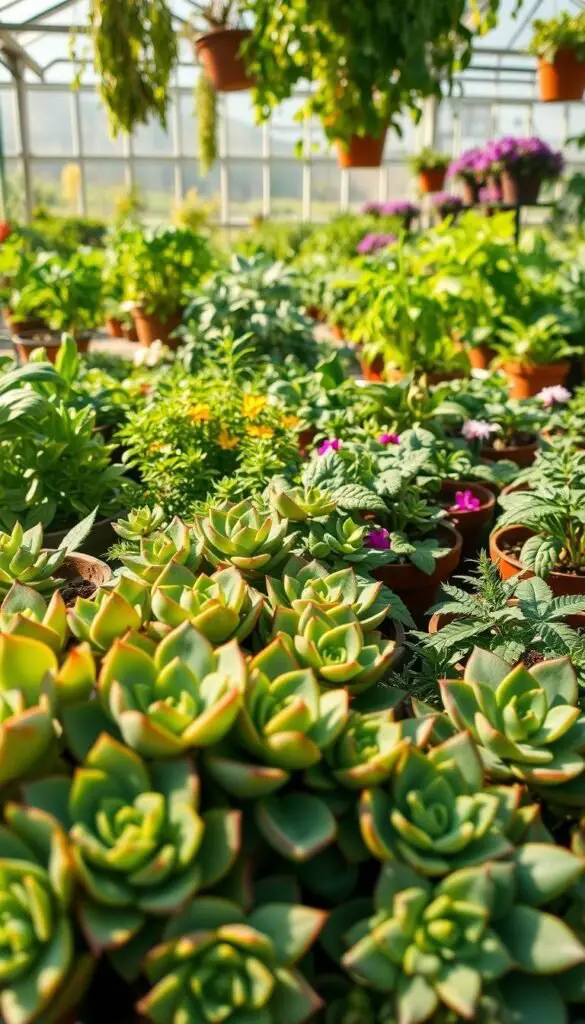
Easy-to-Grow Vegetables
Begin with these easy crops for quick success:
- Lettuce: Harvest in 30-45 days; grows in partial shade
- Radishes: Ready to eat in just 20-30 days
- Cherry Tomatoes: Bush varieties need 60-70 days, perfect for containers
- Zucchini: Space plants 3+ feet apart for big yields
Check seed packets for days-to-harvest timelines and USDA zone recommendations.
Flower Choices for New Gardeners
These blooms add color without constant care:
- Marigolds: Deter pests naturally when planted near vegetables
- Zinnias: Bright blooms from seed in 60-70 days
- Sunflowers: Sow directly in soil for towering, cheerful displays
- Black-Eyed Susans: Return year after year in zones 3-9
Pair flowers with veggies using beginner gardening guide principles. Marigolds near tomatoes, sunflowers as vertical focal points. Always check your USDA plant hardiness zone map for compatibility. Mixing edibles and blooms creates a thriving ecosystem that’s both productive and beautiful.
Soil Preparation for Gardening Success
Healthy soil is key to a thriving garden. Whether you’re how to start a garden or starting a garden as a beginner, knowing how to prepare soil is essential. Small steps like testing pH and adding organic matter can make a big difference.
Testing Your Soil pH
Soil pH shows if it’s too acidic or too alkaline. Most plants like slightly acidic to neutral levels (6.0–7.0). You can buy test kits for under $20 at places like Home Depot or garden centers. Here’s how to use them:
- Collect a soil sample from 3–4 inches deep.
- Follow the kit’s instructions to check pH levels.
- If pH is too low, add lime. Too high? Use sulfur to balance it.
Adding Organic Matter
Make soil richer with organic materials. Add:
- Compost
- Aged manure
- Shredded leaves
Spread a 2–3 inch layer over the soil and till it in. This helps with drainage and feeds good microbes. Even small amounts each year can improve soil over time.
Remember, getting started with gardening means learning as you go. Soil tests and organic amendments are simple steps that pay off season after season. Start small, and watch your garden grow stronger every year!
Understanding Planting Seasons and Timing
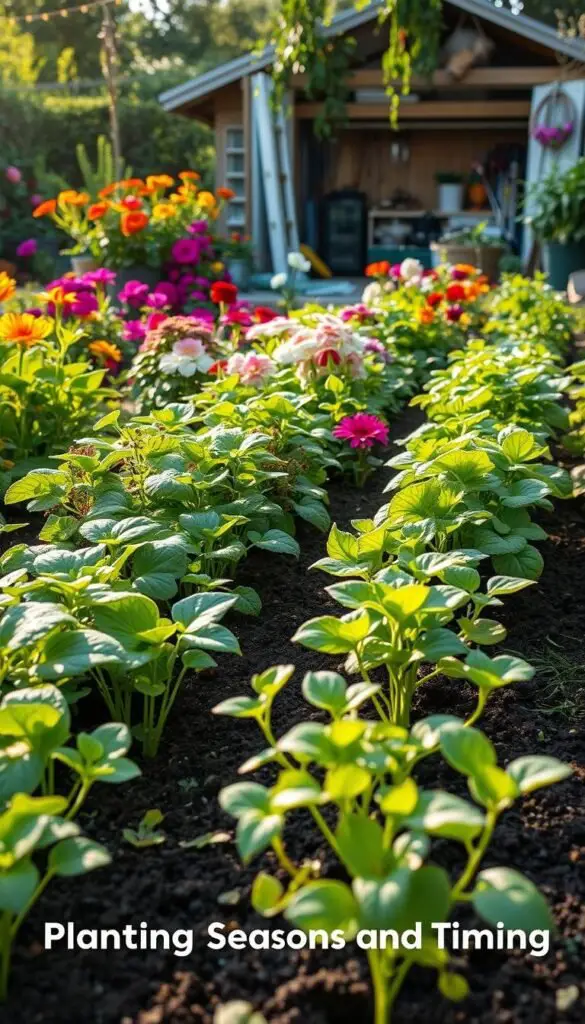
Timing is key in gardening. Knowing when to plant ensures your garden thrives. This section shares gardening tips for beginners on seasonal planting. Learn when to sow seeds and how seasons impact growth.
Cool Season vs. Warm Season Crops
Cool-season crops like lettuce, spinach, and peas do well in 40–75°F temperatures. Plant these in early spring or fall. On the other hand, warm-season crops like tomatoes, peppers, and squash need 60–95°F and lots of sun.
Frost can kill warm-season plants. So, wait until after your area’s last spring frost. Use the USDA Plant Hardiness Zone Map to find your frost dates. Local extension offices offer free zone guides to help plan your Garden For Beginners.
When to Start Seeds Indoors
Starting seeds indoors gives them a head start. Here’s how:
- Find your region’s last frost date via the USDA map.
- Begin tomatoes and peppers indoors 6–8 weeks before that date.
- Use peat pots and grow lights for consistent growth. Check seed packets for specific timelines.
A calendar helps track dates. For example, if your last frost is May 1, start tomato seeds by March 1. Some plants, like carrots, prefer direct sowing. Mix indoor starts with direct sowings for a balanced garden.
Local nurseries or beginner gardening guide workshops can answer timing questions. Remember: patience and planning make all the difference!
Watering Techniques for Healthy Plants
Gardening tips for beginners often stress that overwatering harms plants more than neglect. Start by observing your garden’s unique needs—soil type, plant species, and weather all matter. Here’s how to master watering without guesswork.
How Often to Water Your Garden
Forget strict schedules. Use these beginner-friendly gardening tips instead:
- Test soil moisture with the finger test: Stick a finger 1–2 inches deep. Dry soil means it’s time to water.
- Watch plant leaves. Wilting midday heat is normal, but drooping in the morning signals dehydration.
- Adjust for seasons. Most plants need less water in cool weather and more in summer heatwaves.
Methods for Efficient Watering
Simple gardening for beginners starts with smart tools:
- Soaker hoses deliver water directly to roots, reducing waste. Wrap them loosely around plant bases.
- Morning watering cuts evaporation. Avoid evening watering to prevent mold on leaves.
- Add mulch to lock in moisture. A 2-inch layer of straw or wood chips works wonders.
Pro tip: Collect rainwater in barrels during storms to use later. This saves money and nurtures plants naturally.
Simple Pest Control Strategies
Gardening is a rewarding hobby, but pests can threaten your plants. Beginner-friendly gardening tips often overlook this step. Tackling pests early keeps your garden thriving. Start by learning which bugs to watch for and how to stop them without harsh chemicals.
Common Garden Pests to Watch For
Watch for these troublemakers:
- Aphids: Tiny insects clustering on stems, causing curled leaves.
- Slugs: Leaves with holes and silvery trails at night.
- Cabbage worms: Green caterpillars on brassica plants.

Natural Pest Prevention Tips
Use these easy garden ideas to protect your plants:
- Companion planting: Plant marigolds to repel slugs or basil near tomatoes to deter aphids.
- DIY sprays: Mix water and dish soap in a spray bottle to wash away aphids.
- Physical barriers: Copper tape around plant beds stops slugs instantly.
Integrated pest management balances nature’s tools. If pests overwhelm plants, spot-check organic pesticides like neem oil. Always prioritize prevention over reaction. These how to start a garden basics keep your space healthy without fancy equipment. Small steps like regular inspections and companion planting make all the difference. Stay patient—every garden finds its rhythm over time.
Fertilizing Your Garden for Optimal Growth
Fertilizing is a key step when starting a garden as a beginner. It helps plants grow well without harming them. Let’s look at how to pick and use fertilizers right.
Types of Fertilizers to Consider
Beginners have two main choices: organic or synthetic options. Organic options like compost or manure make soil better over time. Synthetic fertilizers, such as Miracle-Gro or Espoma, give quick nutrients.
Check the N-P-K ratios (nitrogen, phosphorus, potassium) on labels. A 10-10-10 mix is good for most plants. Tomatoes and veggies might need more potassium, like a 5-10-10 mix.
Application Timing and Techniques
When to apply matters. Most fertilizers should go before planting or when plants are growing fast. Here’s how to do it right:
- Test your soil first to avoid too much fertilizer.
- Use slow-release pellets for container gardens.
- Water plants after applying to prevent root burn.
Watch for signs of imbalance. Yellow leaves mean too little nitrogen. Burnt leaf edges mean too much fertilizer. For getting started with gardening, start with half the dose and adjust as needed. Organic gardeners can use compost tea or cover crops to improve soil naturally.
Learning About Companion Planting
Companion planting is a clever strategy for simple gardening for beginners. It matches plants to help them grow, keep pests away, and use space well. It’s a fun way to use tips from the beginner gardening guide and make beautiful, productive gardens.
Many companion planting methods are based on science and tradition. For example, marigolds naturally keep harmful insects away. This blend of old wisdom and new science makes it a great tool for Garden For Beginners.
Benefits of Companion Planting
- Cuts pest problems without chemicals.
- Improves pollination for better harvests.
- Helps plants share space efficiently.
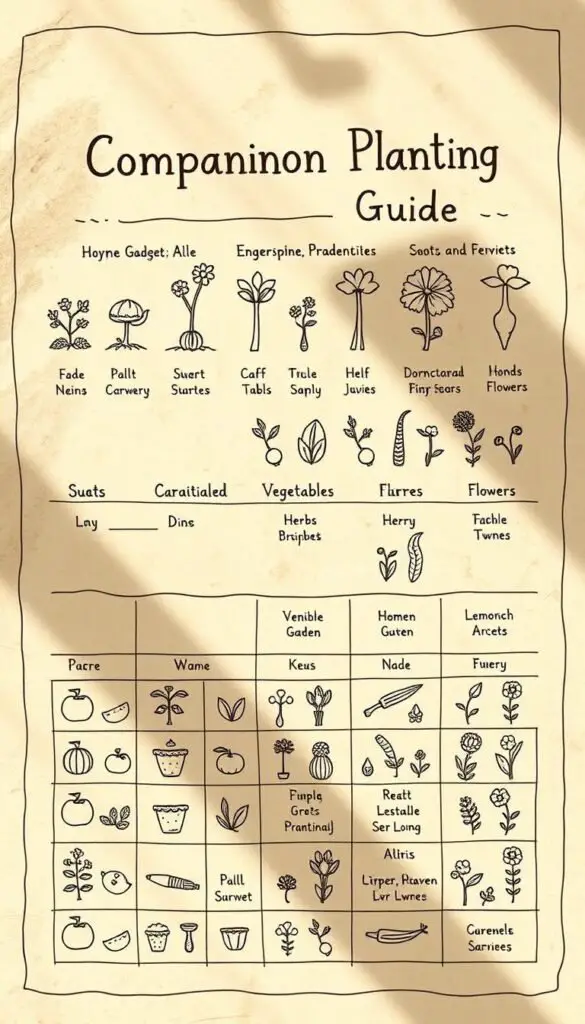
Popular Companion Plant Pairings
- Tomatoes + Basil: Boosts tomato flavor and repels insects.
- Carrots + Onions: Their scent confuses pests and improves growth.
- Marigolds + Vegetables: Flowers act as natural pest shields.
Try themed gardens like salsa gardens (tomatoes, peppers, cilantro) or butterfly gardens (milkweed with flowers). Mix and match to match your goals. Start with these proven pairs from the beginner gardening guide, then experiment as you gain confidence. Every choice in the simple gardening for beginners journey can lead to surprising successes!
Harvesting Your Garden’s Produce
Gardening tips for beginners often focus on planting and care. But knowing when and how to harvest is key. This guide will show you simple steps to get the most from your garden without harming your plants.
Signs Your Plants are Ready to Harvest
Watch for these cues to time your harvest right:
- Color and Firmness: Vegetables like tomatoes and peppers should feel solid and show vibrant color. Soft spots or wrinkles signal overripeness.
- Leaf Size: Leafy greens such as lettuce taste best when leaves reach 4-6 inches tall. Snip outer leaves first to let inner ones grow.
- Flower Blooms: Harvest herbs like basil when flower buds appear—this boosts flavor before plants go to seed.
Best Practices for Harvesting
Use these easy garden ideas to protect plants and prolong harvests:
- Cut herbs in the morning after dew dries but before midday heat.
- Use clean shears to avoid damaging stems—sharp tools prevent disease spread.
- Harvest frequently! Regular picking encourages plants like beans and zucchini to produce more.
“A little patience and the right timing can turn a garden into a year-round food source.” – National Gardening Association
Starting a garden is more than just planting—it’s about nurturing plants through every stage. Proper harvesting boosts future yields and keeps plants healthy. Store produce correctly: refrigerate greens in damp towels, and air-dry herbs before storing. Enjoy your bounty while learning to adjust techniques for next season’s growth!
Continuing Your Gardening Journey
Gardening is a skill that grows with time. As you gain confidence, exploring resources and connecting with others can turn your hobby into a lifelong adventure. Here’s how to keep learning and thriving in your green space.
Resources for Growing Your Expertise
Books like The Vegetable Gardener’s Bible by Edward C. Smith offer practical beginner-friendly gardening tips. Online platforms like Gardeners.com provide guides for every season. Podcasts such as The Urban Farmer Show and apps like PlantSnap help identify plants and track growth.
Online courses on Coursera or edX even teach advanced techniques for those ready to go beyond basics.
Joining Local Gardening Communities
Local garden clubs or community gardens let you share advice with neighbors. Programs like the USDA’s Master Gardener network offer free workshops tailored to regional plants. Social media groups (like those on Facebook or Nextdoor) connect beginners with mentors.
These groups turn questions like “When to prune tomatoes?” into shared learning opportunities.
Every season brings new lessons—like how to protect plants during frosts or design drought-resistant beds. Celebrate small wins, adapt to challenges, and remember: even seasoned gardeners learn something new each year. Your first plot is just the start of a rewarding journey.

